PPC
7 Competitive Analysis Templates to Improve Your Performance & Get Ahead

Every business needs KPIs to measure success and goals to strive for. But you shouldn’t be comparing your performance to just…well…your own past performance. In order to grow, you need to be aware of where your company stands in relation to others in your market.
Enter: the competitive analysis.
In this post, I’m going to share seven different competitive analysis types and for each one, I’ll define it, give some examples, and provide a template. Get them before your competitors do!
Table of contents
What is a competitive analysis?
A competitive analysis is a systematic method of comparing your business to its competitors with regard to a set of criteria. Systematic, however, does not mean rigid. In fact, competitive analyses are very versatile:
- You can examine direct or indirect competitors.
- You can look at your entire business or just specific strategies.
- There is no right or wrong criteria.
- There are marketing competitive analyses, sales competitive analyses, project competitive analyses, and the list goes on.
It all comes down to what you are trying to achieve. You can use competitive analysis to:
- See where you stand in your existing market.
- Improve performance in your existing market.
- Stand out from your competitors.
- Bring a new product to market.
- Enter into a new market.
The world is your oyster, so let’s get crackin’.
7 competitive analysis templates and examples
With the above being said, here’s a look at seven different types of competitive analyses. Use the examples and templates as a starting point, and adjust them according to the marketing metrics that are most important to you.
1. Basic marketing competitive analysis template
If you’re unsure of what you’re trying to measure or what your specific goals are, here’s a super basic marketing competitive analysis template that pulls together the key things to know about your competitors. This includes:
- Tagline: A short but powerful statement that can help you understand the intended value proposition of the business.
- Target market: Who is their main audience?
- Personas: What types of personalities, lifestyles, wants, and needs do your competitors cater to?
- Top organic keywords: What topics do they specialize in?
- Top paid keywords: Where are they spending their budget?
- Main marketing channels: Email, social, website, listings, reviews?
- Content types: Blogs, guides, videos, newsletters, ads?
- Reviews: Do they have a proactive review strategy? Which platforms do they have the most reviews? The best reviews? The worst?
- Social presence: What channels do they use? How active are they?
- Overall brand voice: What is the look and feel of their brand?
This will give you a big-picture understanding of each of your competitors and inspire ideas for you.
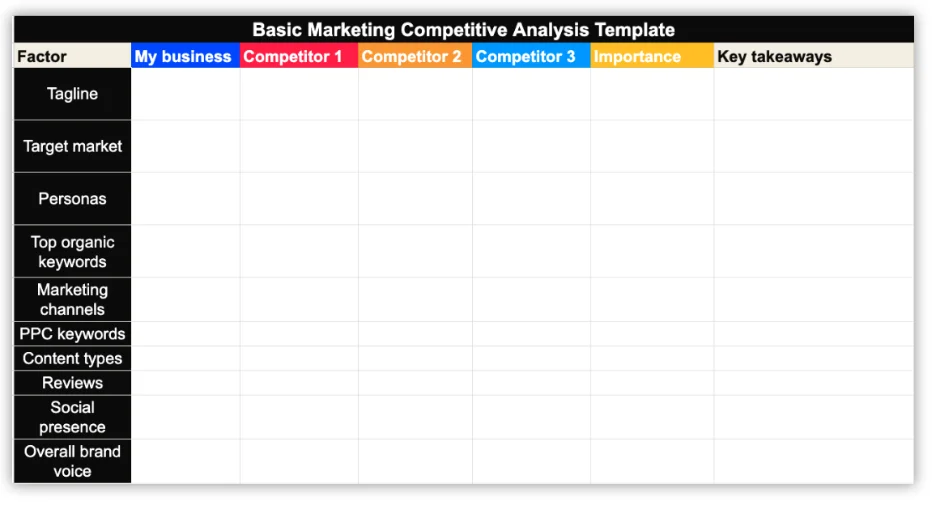
Go to the basic marketing competitive analysis template
2. SWOT analysis
Perhaps the gold standard of competitive analyses, SWOT stands for strengths, weaknesses, opportunities, and threats.
- Strengths: What do you do well that your competitors don’t?
- Weaknesses: What do your competitors do well that you don’t?
- Opportunities: What do neither you nor your competitors do well, or where can you harness your strengths for a competitive advantage?
- Threats: What could hinder your business growth? Where could your competitors harness their strengths for a competitive advantage?
SWOT competitive analysis example
Here’s an example of a SWOT competitive analysis for a local restaurant:
- Strengths: Excellent location, lots of foot traffic, good reputation among the local community, seasonal menu, eco-friendly brand, locally sourced.
- Weaknesses: Higher costs and longer wait, less brand awareness, single location means limited reach, no online reservations.
- Opportunities: Growing interest in/support for locally sourced/sustainable ingredients; season keeps things fresh and interesting; potential for growth via food delivery apps/technology.
- Threats: Intensifying competition from established chain restaurants; uncertain economic environment; rising cost of ingredients, food delivery apps/technology.
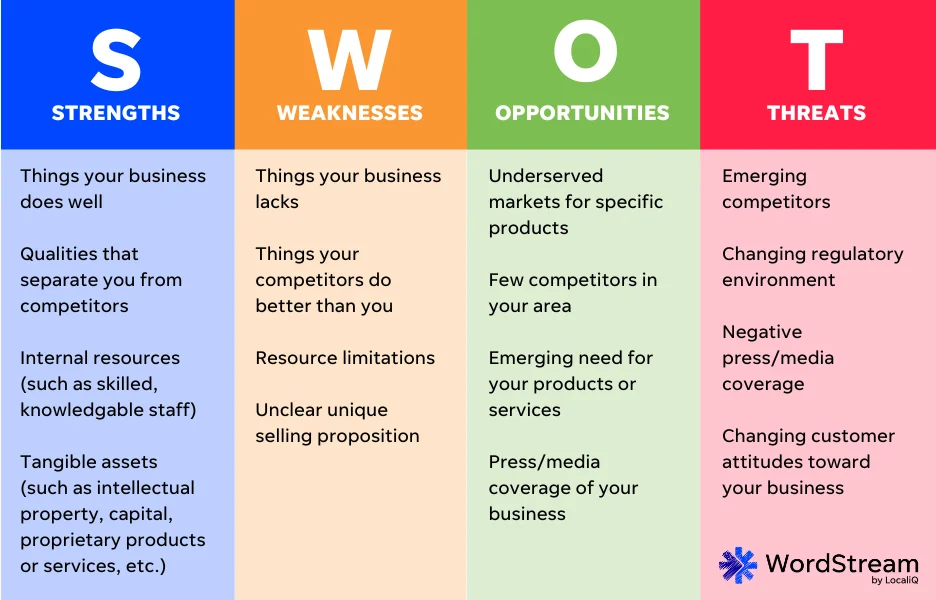
SWOT analysis template
Our SWOT analysis template has a checklist of questions to ask in each category to help you do a thorough analysis and uncover actionable insights. It also is accompanied by a comprehensive blog post that covers everything you need to know about SWOT.
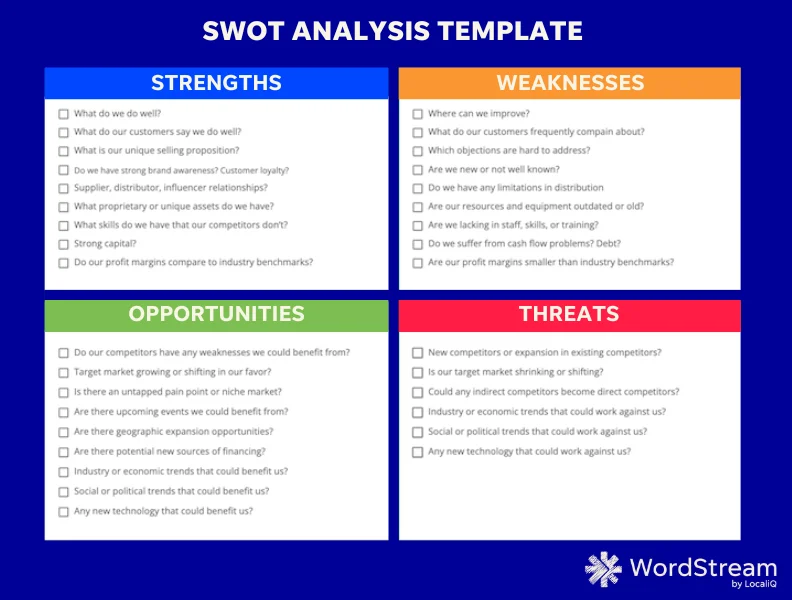
Go to this SWOT analysis template
3. Keyword competitive analysis
A keyword competitive analysis will take your keyword research to the next level. With it, you look at your organic and/or paid keywords in comparison to those of your competitors.
The idea is to find out what keywords are realistic to target to outrank your competitors and which ones are not. Because targeting keywords you’re not going to rank for—whether for SEO or PPC, is a waste of time and budget.
Keyword competitive analysis example
Let’s say you are a communication platform that streamlines email, text, and phone communication for home improvement businesses. Your bread and butter (your S in SWOT, if you will) is text automation, and you want to start running PPC ads for it. Perfect opportunity to do a paid keyword competitive analysis.
There are plenty of tools to help you find competitor keywords.
For this example, I put Podium’s domain into Semrush, filtered for keywords NOT containing “podium,” and that have an average position of one, then sorted by traffic to the corresponding landing page.
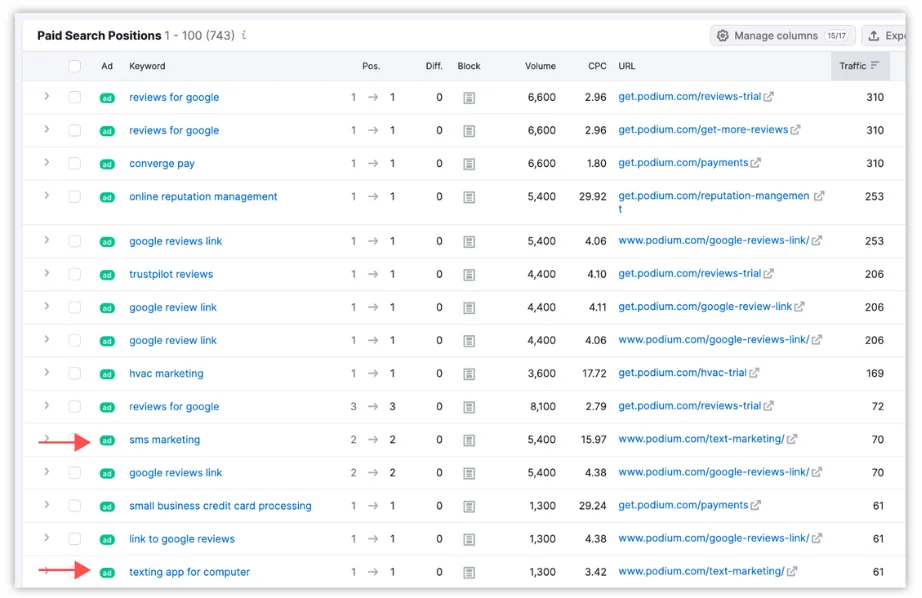
As you can see, the top keywords include:
- Reviews for google (310 visits a month)
- Converge pay (310)
- Online reputation management (310)
- Hvac marketing (169)
“Sms marketing” is further down the list at 70 visits per month.
It appears as though Podium is more interested in online reputation management and payment processing, so this could be an opportunity for me. Also, with” HVAC marketing” getting comparable traffic, I might want to look further and see if this is a niche Podium specializes in or if this is a particularly fruitful market.
Keyword competitive analysis template
WordStream’s competitor keyword analysis template includes columns for the keyword, search volume, competition, cost per click, funnel stage, intent, competing domain, and corresponding page. There are also two columns where you can mark off whether you’re already targeting that keyword and what the action is—you may need to improve your strategy for a particular keyword, start targeting new keywords altogether, or let some go.

Go to this competitor keyword analysis template
4. 7P competitive analysis
The “7 P’s” refer to the seven elements of the marketing mix. It’s a framework designed to help you understand your own company, but you can also run the same framework on your competitors to identify opportunities for growth. The 7 P’s are:
- Product: Think about specific features around quality, variety, customer support, use cases, availability, warranty, and more.
- Price: Not just cost, but, discounts, payment methods, financing options, add-ons, and more.
- Place: Where is the product or service sold, what channels are most successful?
- Promotion: What marketing strategies do you use? SEO, social, branding, PR, PPC, etc.
- People: What is the organizational structure? How about culture? Skills and talents? Hiring and recruiting methods? For some companies, you can get a pretty good idea of team structure by looking at its employees on LinkedIn.
- Process: How does the product or service get delivered to the customer? Is there interpersonal interaction between business and client? Self-service features?
- Physical evidence: How do you prove that your solution is the right one? What physical assets exist that legitimize your business?
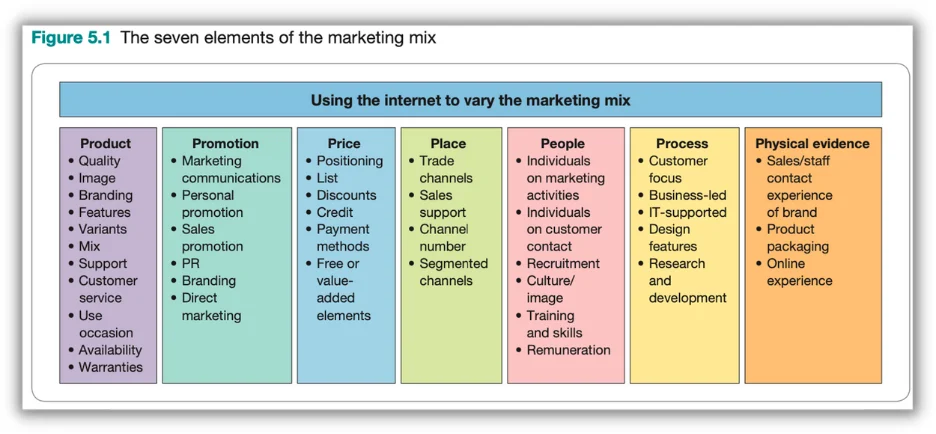
7P competitive analysis example
Here’s an example of a 7P competitive analysis for a video advertising company.
- Product: Video advertising services with in-house videographers for custom ad creative, special proprietary budget optimization technology, and access to a unique network. Also, a helpful website to determine which video ad types will be best.
- Price: Prices are higher than most ad agencies, but because it includes custom design services, budget optimization, and multi-channel strategy, the total cost is cheaper. Plus, more effective ads have lower costs per click and higher ROI.
- Place: Anywhere in the US, as the team can operate and serve remotely.
- Promotion: Able to show its strengths through its own stellar video advertisements, also uses video marketing industry content and DIY how-tos for SEO and website traffic. Not a lot of PR, a big focus on branding.
- People: Large development team heavily focused on the proprietary software, small marketing team as in-house designers produce much of the lead-generating content; large sales team that also shares in customer success. Remote team but prioritizes company culture and social responsibility, helps out in communities.
- Process: Mainly do-it-for-me with regular performance review meetings and some self-serve features and tools.
- Physical evidence: Gallery of video ads and video testimonials created for clients plus its own content on its site. Large YouTube following and even Spotify playlist following.
7P competitive analysis template
This 7P competitive analysis template is a spreadsheet that includes each of the seven Ps and then columns for you to fill in for your business and your competitors. There’s also a column to indicate level of importance for each factor and any key takeaways or action items.
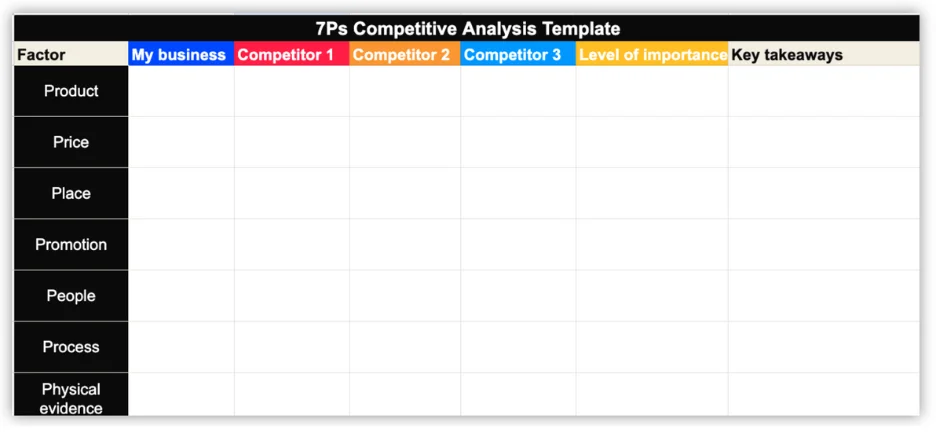
Go to the 7P competitive analysis template
5. Social media competitive analysis
A social media competitive analysis is…wait for it…an analysis of your competitor’s social media strategy in comparison to yours. It’s helpful in getting ideas for social media content, distinguishing your brand voice, finding hashtags, and more.
There are dozens of specific social media metrics you can look at, but I recommend just the basics:
- What platforms are they on?
- Which is their favored platform?
For each platform:
- Target audience
- Tone of voice
- Types of posts
- Posting frequency
- Follower count
- Engagement
- Hashtags
Social media competitive analysis example
Here’s an example of a basic social media competitive analysis I did on Chirrp, a texting automation software.
- Platforms they’re on: Facebook, YouTube, LinkedIn
- Favored platform: YouTube
- Facebook: 937 followers, 1-2 posts per month, 790 likes, promotional, testimonial, videos and quotes, 1-3 likes per post, #chiirp;
- Don’t be fooled by the cuteness of our little bird… she is the most dangerous marketing tool on the planet
- LinkedIn: 137 followers, only one post, five months ago, for a job listing.
- Chiirp is the ultimate communication and marketing automation toolbox for hind service companies.”
- YouTube: 441 subscribers, 177 videos, 1-2 videos per month; interviews, webinars, and demos promoting the product
From this analysis, I can see that Chiirp doesn’t prioritize social media marketing aside from video and YouTube. From here I’ll want to understand if that’s because of limited resources (in which case this is an opportunity to fill a gap) or because social isn’t the best channel for this particular target market (in which case I shouldn’t prioritize social either).
Social media competitive analysis template
This social media competitive analysis template covers the points above, for the most popular social media networks: Facebook, Instagram, LinkedIn, TikTok, and YouTube. It also includes columns for top followers, notes, and a link to each profile.

Go to the social media competitive analysis template
6. PEST competitive analysis
You can think of a PEST competitive analysis as sort of a deeper dive into the threats of your SWOT analysis. As we mentioned, threats are typically driven by factors that are outside of your control. This includes:
- Political: Laws and regulations, taxes, and even political forces that impact the ease of doing business in your market.
- Economic: Inflation, stock exchange rates, interest rates, labor costs, supply chain, sales cycle patterns—anything influencing your ability to make and spend money.
- Social: Demographic and population patterns, consumer behaviors, and cultural shifts that impact interest in your business or products/services.
- Technological: Tools, platforms, and technology that may compete with your offerings or give your competitors an advantage.
PEST competitive analysis example
Here’s a basic run-through of some of the PESTs impacting a communication platform primarily for home service and home improvement businesses.
- Political: New opt-in and consent rules and regulations around texting are ramping up. But this presents an opportunity to create templates, educational content, and product offerings that make these compliance hassles easier.
- Economic: Supply chain shortages and seasonality can dramatically impact any given vertical’s interest in the product.
- Social: With the pandemic over, people are less into DIY home improvement and are turning back to the pros. Also, with millennials and Generation Z getting older and being less interested in DIY home improvement (and more interested in saving the world from itself), the home service industry is expected to grow.
- Technological: AI, combined with personalized automation, presents a huge opportunity for call centers to become leaner and more powerful.
PEST competitive analysis template
Use this PEST competitive analysis template to compare the challenges you’re facing to those of your competitors. And remember, your competitors’ challenges can become your opportunities.
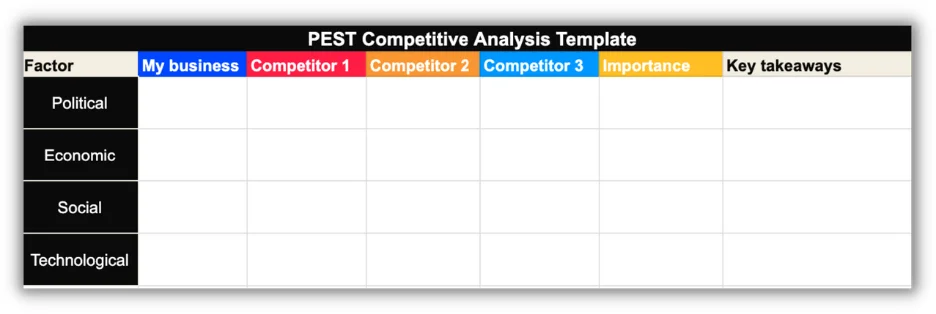
Go to the PEST competitive analysis template
7. Porter’s Five Forces competitive analysis
This framework got its name from Harvard Business School professor Michael Porter, who created it in 1979. The model examines five market forces that affect companies in any industry, including:
- Threat of new entrants: The more players in an industry, the higher the competition, but some industries are easier to enter into than others. The ease with which a new business can enter into an existing industry depends on up-front costs, training, and certifications, as well as the power of existing brands in the space.
- Bargaining power of suppliers: How much power do suppliers have to raise prices which would in turn decrease profitability? This depends on how many suppliers are already in the space and the availability of alternatives and substitutes.
- Bargaining power of buyers: This represents how easy it is for customers to switch from one brand to another, such as for better pricing. When there are few customers and many alternatives, bargaining power is high, not to mention that price comparisons are more accessible now thanks to the internet. (This is why building brand loyalty and truly distinguishing your products and services is so important!)
- Threat of substitute products: Think not just about identical products and services but also different ones that meet the same need.
- Rivalry among existing competitors: When rivalry is high, industry players have to invest more in advertising and sometimes partake in pricing wars, which impacts profitability.

Five Forces competitive analysis examples
- Threat of new entrants: For example, the hotel industry is a lot harder to enter into than say, the home services industry, but home services is still harder to enter into than food and beverage.
- Bargaining power of suppliers: An example here would be in the restaurant industry. Supplies are more abundant for fast food than for farm-to-table, so supplier power would be higher for the latter.
- Bargaining power of buyers: In industries like real estate, hotels, and travel, buyers have access to a wealth of price comparison tools, making buyer power very high.
- Threat of substitute products: Let’s take the beer industry. While spiked seltzer is not the same type of product, it serves the same purpose in many ways, and can therefore be a threat.
- Rivalry among existing competitors: Because of its difficulty to enter, the airline industry has fewer players and therefore higher competition. Add in the high bargaining power of buyers and suppliers and the competition is even more fierce.
Five Forces competitive analysis template
Use this template to examine your business and your competitors with respect to Porter’s Five Forces.

Go to the Five Forces competitive analysis template
Use these competitive analysis templates and examples to grow your business
A good business measures its performance, but a great business takes a step back and looks at its performance relative to the competition. And now you’re equipped with seven different competitive analysis examples and templates to help you do that.
Which one is best for you? It all depends on what you’re trying to accomplish, whether you’re trying to solve a problem, achieve a goal, or find out something new.


















